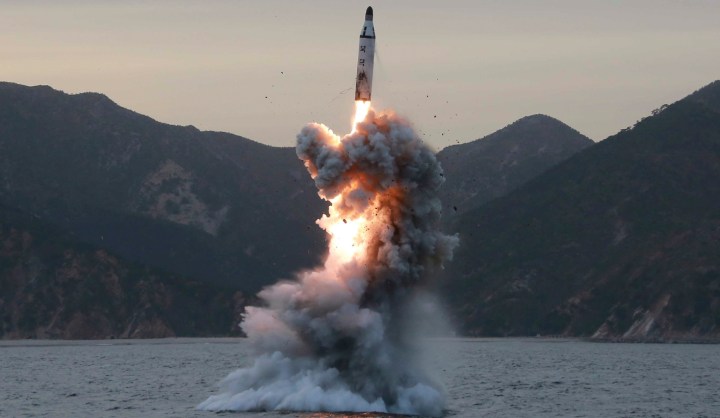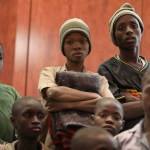World
Trump vs Kim Jong-un: When Bluster trumps Diplomacy

The Yalu River – the boundary between North Korea and China – was where American and Chinese troops met and engaged in combat in the midst of the Korean conflict back in 1950-51. The Chinese had taken the defeat of their North Korean allies by UN forces rather badly and so they massively intervened. But, even more than North Korea’s defeat, the Chinese were much more discomfited by the possibility that the US would have its ground forces perched right on the Chinese border. J. BROOKS SPECTOR looks at the newest Korean crisis in light of that history and the psychology of crisis management, and is not particularly amused or comforted so far by reassurances from US officials.
The last time the United States was engaged in a shooting war on the Korean Peninsula, it was back in 1950-51, before the conflict’s ceasefire came into effect. And, of course, that war has never really ended. Instead, Kim Il Sung became the permanent leader of the People’s Democratic Republic of Korea, North Korea for short, until he died. His son – and now his grandson – have taken charge in sequence. A hereditary-state-socialist-monarchy.
Anyone who has predicted the DPRK’s collapse over the years, on the basis of political repression, perpetual economic disaster, agricultural collapse, famine and other assorted devastation, has been nonplussed by the regime’s extraordinarily resilient – and thoroughly totalitarian – continuing existence.
As part of founder-grandson Kim Jong-Un’s efforts to insulate his regime from the possibility of his hermit kingdom being invaded by its sworn enemies (whether or not this fear is even rational), the Young Leader has been aggressively pushing for his very own doomsday weapon. The pace from the time of his father has been significantly ramped up, and vast resources have been poured into this programme, despite the scarcity of national wealth and skilled manpower in the country.
Over the years of his reign, the country’s military scientists and engineers have moved forward on the complexity and range of its missile force. Concurrently, his nuclear scientists have been creating, first, a working nuclear device, and then, second, miniaturising that device so that it can be married to the missile fleet. Moreover, guidance systems sufficient to deliver the combined missile/weapon to an intended target have been worked on hard, along with the engineering sufficient to keep the weapon from being vapourised during the missile’s speedy re-entry phase into the denser atmosphere – lest it be burned up before ever reaching its target.
Without all of these complex elements working reliably, the assumed North Korean weapon is just so much Ruritanian pomp and ceremony – suitable only as a prop for one of those interminable military parades the Kim family seems to revere. Nonetheless, even the mere possibility of success in that nuclear missile programme has been more than sufficient to frighten the wits out of otherwise sober-minded nuclear strategists in capitals and think tanks around the world.
Way back in the 1990s, the Clinton administration, increasingly worried North Korea was about to create a sustainable plutonium breeder reactor (plutonium being one of the two alternative radioactive elements crucial for a working atomic bomb), negotiated a rather comprehensive accord that would have provided alternative fuels such as high grade bunker oil to power conventional generators and assistance towards reactors that did not generate plutonium. In return there would be inspections and various other safeguards under a new, purpose-built international entity, the Korean Energy Development Organisation. As part of the overall warming of relationships, the US was poised to establish a liaison office (a kind of almost-but-not-quite-embassy in Pyongyang) and the North Koreans would set up the equivalent in Washington.
This writer had a modest part in all this heady diplomatic flurry of activity. One of my tasks was to generate publications, published in Korean, that could be made available to be handed out by the staff of that semi-sorta-embassy to any Koreans in Pyongyang who would receive them. Of course, North Korean government watchers would carefully screen any recipients and probably try to seize the publications, but, regardless, the items would probably end up being read by many more people anyway, as the material seeped into the more general population. (One idea that was turned down was to obtain thousands of copies of the Lotte department store Christmas catalogue – Lotte being a major South Korean store chain – and mail them to every address that could be identified in North Korea. This would generate an unbreakable consumer demand for the products of capitalism. Although a fun idea, it was ultimately rejected as just a little too bold and too provocative.)
We selected a list of the obvious kinds of items: potted geographies and histories of the US, and discussions of American arts and literature, but also, thoughtful pamphlets on important western economic ideas and trends. We then commissioned new translations into Korean, only to discover that the North Korean version of the language simply did not contain words for dozens and dozens of standard use economic and business terms – and using the South Korean lexicon would have been devoid of meaning to would-be readers. And so, our translators had to build the required lexicon themselves.
Duly printed, pallet loads of publications were dispatched to a warehouse in South Korea to be driven overland to Pyongyang when that liaison office was to receive its tables, chairs, computers, carpets and communications gear. But the diplomatic climate over KEDO and the establishment of those liaison offices suddenly turned arctic cold by a twist in Pyongyang thinking. KEDO never took off, the liaison offices were never opened, and those pamphlets and books are – presumably – still in their tightly wrapped pallet loads, waiting for the right moment. Given current circumstances and the level of discourse between the US and North Korea right now, that is not likely to be any time soon.
And that, of course, brings us to those awkward current circumstances. As it has become increasingly likely the North Koreans have cracked the tasks of building a reliable intercontinental missile, a shrink-wrapped warhead, a suitable guidance system, and the shielding to protect everything on re-entry, Kim Jong-un’s increasingly bellicose accompanying rhetoric has been paralleled by some similarly bellicose rhetoric from that equally calm-headed occupant in the White House.
In the most recent cycle of reciprocal name-calling and dire threats, Kim has threatened to use his new toys on the US, and most especially, to bracket the island of Guam with missiles. That island in the western Pacific is home base to a variety of long-range US bombers, some 7,000 US military personnel, and about 160,000 residents. And, on any given day, thousands of Japanese tourists.
Meanwhile, the Trumpster has threatened – in this escalating shouting match – to deliver a reign of “fire and fury” and “real power” on North Korea. This presumably would be aimed at eliminating nuclear installations and missile sites, and implying strongly the use of nuclear weapons, if the Pyongyang regime does – or tries – anything like plunking some of its new missiles around Guam, let alone towards the continental US. (There is the “fun” fact of learning that the locution of “fire and fury” has another life in an online combat game that presidential adviser and Trump whisperer Steve Bannon had a hand in in promoting in his pre-White House life.)
Regarding Trump’s use of that rhetoric the other day, this was clearly not the product of any careful calculation and staff work on the part of the State and Defence Departments, and the National Security Council. Rather, while appearing in a media event related to discussions on the opioid epidemic ravaging communities in the midst of his working vacation at his golf club in New Jersey, this Trumpian phrasing apparently just popped out – surprising most senior advisers, security policy bureaucrats, military figures, and allies alike – not to mention observers in North Korea, Russia and China.
Some American officials – as with Secretary of State Rex Tillerson during his return from an Asian leaders meeting in Manila and some time in Bangkok – have been forced to try to tamp down the rhetorical excess, telling reporters Americans can still sleep easily, not to worry, no problem, it’s just a little over-the-top language. And all this has come just as the US had actually achieved a notable diplomatic success in getting the UN Security Council to agree unanimously – 15-0 – on a rebuke of North Korea and the imposition of further economic sanctions. The Russians and Chinese seem to be saying that the trash talk should be at an end and the real negotiations must begin – and China even pledged to cut back on North Korean imports in accord with the UN decision.
Not surprisingly, all this bilateral rhetorical overkill has gotten the Japanese rather upset – in part because of their own rather unhappy nuclear history, and in part because any launch trajectories towards Guam from North Korea would necessarily fly over the Japanese home islands. Meanwhile, the South Koreans are increasingly discomfited because there is awareness that in any real shooting, the North has already gotten the range settings right for thousands of their artillery pieces of that vast urban conurbation of its capital. Seoul is just over the Demilitarised Zone, some 50 kilometres north of the city.
While it is impossible to tell just how precisely and finely calibrated Kim’s regime’s increasingly histrionic rhetoric is this time around, it is largely in the style of past crises and tensions involving North Korea. By contrast, the Trumpian rhetoric is rather off the charts as far as American diplomatic speak is usually rendered. Especially when the possibility of nuclear devastation can be glimpsed on the horizon.
This kind of loose-lipped, “my hands aren’t tiny”, teenaged swaggering, faux bellicosity (from Kim and Trump both – Kim especially likes threatening destruction in a “sea of flame”) stands in direct contrast to the way things were carried out when the world really did face the actual possibility of nuclear warfare, back in 1962. Back then, in an effort to recalibrate the strategic balance, the USSR secretly installed nuclear missiles in Cuba. For their part, as new Russian allies, the Cubans had egged them on to do this as an insurance hedge against any future American-supported invasions of the island, such as the ill-fated Bay of Pigs landing by Cuban exiles in 1961.
When it became clear those Russian weapons represented a game changer in the midst of the Cold War, the US insisted upon their withdrawal, imposed a naval quarantine around Cuba to prevent additional ones from arriving, and kept in close touch with Soviet leaders to insist upon compliance and agreement. What the US president did not do, however, was to engage in a rhetorical battle of the bands with Nikita Khrushchev, the then-Soviet premier. And most especially, the Kennedy administration insisted that US military officers should understand their orders so precisely that no “damned fool” could set off World War III by accident or misadventure.
For his part, too, it seems that once the Soviet leader came to grips with the stakes of that potential conflict, the Russians too tried hard to de-escalate the confrontation. Back channel negotiations began to establish a broader basis for agreement and to work out a confidential nod for the withdrawal of the missiles paired with the gradual decommissioning of now-obsolete US missiles then based in Turkey and Italy, and agreement not to invade Cuba. But the whole thing required as little grandstanding as possible.
Sadly, right now, the world has two men who seem to thrive on grandstanding for the electric effect it has on everybody else. However, the current crisis could rapidly spiral out of control, if someone (at the top or much further down the line) makes a mistake, takes a bluff badly, or poorly interprets the “now what do we do” question via a hair-trigger, off-the-cuff response. We’ll all find out soon enough. DM
Photo: An undated file photo released by the North Korean Central News Agency (KCNA), the state news agency of North Korea, shows an ‘underwater test-fire of strategic submarine ballistic missile’ conducted at an undisclosed location in North Korea (reissued 22 March 2017). North Korea is under tough UN sanctions following its recent nuclear and missile tests at a moment of great tension in the Korean peninsula. EPA/KCNA



















